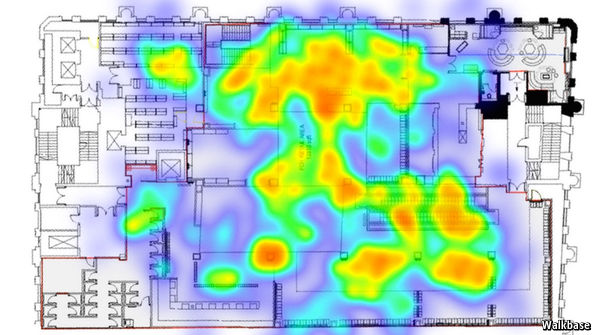There is money to be made in tracking shoppers’ paths inside stores
Dec 24th 2016

“LOOK up there,” says Edward Armishaw of Walkbase, a Finnish retail-analytics firm, as he points to a small white box above a column cladin mirrors. The sensor—and over a hundred others like it hidden around this department store in London’s Oxford Street—tracks the footsteps of customers through the pings their smartphones emit in search of a blooming bluetooth signal. Quite unaware, a shopper in a silver puffa jacketamblespast and over to the fitting room. Whether she moves to the till will be logged by Walkbase and its client.
“往上看一看。”一位来自芬兰名为Walkbase零售分析公司的Edward Armishaw说到,他随手指向了镜面柱子上方的一个白色盒子。这是一个通过顾客的智能手机所释放找寻蓝牙信号来追踪他们足迹的传感器,在伦敦市牛顿街上,有上百个类似的传感器隐藏分布在各大百货公司中。一位身着银色羽绒夹克的顾客漫步走进试衣间,对此毫无察觉。Walkbase和它的客户会记录下她是否走到了柜台。
Think of it as footfall 2.0. For many years shops used rudimentary“break-beam” systems—lasers stretched across their entrances—to count people in and out. Only recently have they begun to follow customers inside their buildings, says Nick Pompa of ShopperTrak, an American firm whose work with 2,100 clients worldwide, including malls in Las Vegas and in Liverpool, makes it a giant in the area.
人们把这种传感器看作是footfall 升级版。长久以来,商店使用尚未成熟的“break-beam”系统来计算进出的顾客数量,这主要是利用蓝牙信号计算进出大门的人数。“直到最近,人们才开始追踪走进他们大楼的顾客。”美国公司ShopperTrak的Nick Pompa 谈到,这家公司是这个领域里的巨头,他们为全世界2100名客户服务,其中包括拉斯维加斯和利物浦的商场。
Tracking technologies are ingenious. Some flash out a code to smartphone cameras by means of LED lighting; others, such as IndoorAtlas, a startupwith headquarters in California and Finland, monitor how devices disrupt a store’s geomagnetic field. With smartphone ownership rising, the market for tracking phones indoors could grow fivefold between now and 2021, to a total of $23bn, says Research and Markets, a market-research firm.
追踪技术是极其巧妙的。一些是通过LED灯光这种方法向智能手机的镜头闪光传递一段编码;其他诸如在加利福利亚州和芬兰都设立总部的新兴公司IndoorAtlas监视设备是如何扰乱一家商店的磁场。随着拥有智能手机的人数增多,一家名为Research and Markets的市场研究公司表示,追踪室内手机的市场可能在从现在起到2021年的这段时间内快速增长五倍,市值总额达到230亿美元。
What do retailers hope to gain? The answer depends on how far they push the technology. On the most basic level, a store might notice that people often walk from “frozen goods” to “alcohol”, and then bring the two closer together. A retailer could also gain more insight into which departments are best at promoting goods—all without knowing anything about shoppers beyond where their legs take them.
零售商期待什么样的回报呢?这个问题的答案取决他们推动这项科技进步的程度。从最基本平面来看,一家商店可能注意到,人们总是从“冷冻食品区”走到“酒类专区”,因此把这两类商品紧紧放在一块;一位零售商也可能更加了解哪一个零售部是最有擅于促销商品,这一切只用了解顾客会在哪些地方徘徊就够了。
If stores can persuade clients to reveal personal information, too, theystand toprofit more.Some 200,000 shops around the world now have systems to track phones, including free Wi-Fi, according to ABI Research. The often-overlooked terms and conditions for Wi-Fi typically allow stores to see a shopper’s online search history as well as track their location. This can open up a “gold mine” of data, points out Dan Thornton of Hughes Europe, a network provider. Daring retailers already use it to target extremely personal, location-based advertisements to customers’ phones. If someone googles a rival while in a suit shop in one of Australia’s Westfield shopping malls, for example, Skyfii, the startup that provides their internet service, is ready to send a wavering client a discount on the spot.
如果商店也能够说服顾客透漏一些个人信息,他们就能够获利更多。根据ABI研究机构得出,全世界约二十万家商店现在拥有追踪手机信号的系统,其中包括免费的Wi-Fi。这些常常被忽略掉的Wi-Fi条件一般可以让商店查看顾客的在线搜索历史追踪他们的位置。一家名为Hughes Europe网络供应商的Dan Thornton指出,这些信息能够开辟一座数据“金山”。一些勇于冒险的零售商已经使用这种系统来专项传递极其个人的、基于空间定位的广告给顾客的手机。例如,如果某人在澳大利亚其中一家Westfield购物中心的一家西装店谷歌搜索相同款的西装,那么提供互联网服务的Skyfii公司就会准备给现场犹豫不决的客户发送打折信息。
But the speed of travel towards a world in which Gap, a retailer, can greet each customer individually, as in the 2002 film “Minority Report”, has been much slower than expected, says Tim Denison of Ipsos Retail Performance, a British firm. That is partly because most shops are waryof tracking people quite so closely. European ones are particularly worried that they could spark abacklash over privacy.
但是,一位来自Ipsos Retail Performance英国公司的Tim Denison表示,即使如Gap这样的零售业巨头能够像2002年的电影“Minority Report”中一样分别问候每一位顾客,但是这种发展速度还是低于预期的。部分原因是由于大多数商店对详细追踪人们信息是持警惕的态度,欧洲的商店特别担心他们可能因为隐私问题遭到强烈反对。
Soon, though, such concerns may be swept away. Apple and Google have built up their own expertise in indoor location, and to Patrick Connolly of ABI Research, it is clear that they plan to drop a “bombshell” on the retail industry. Currently an iPhone or Android handset can direct its owner to the shops, but not inside them, let alone to the nearest pair of blue underpants. That is because GPS satellite signals bounce off walls, depriving a smartphone of what it needs to locate itself.
然而,诸如此类的担心可能很快就一扫而空。苹果和谷歌公司已经搭建他们自己专属的室内定位系统,同时对于ABI研究机构的Patrick Connolly,他们打算在零售业引起爆炸性事件的计划是显而易见的。目前,一部iPhone或Android手机能够告诉机主商店的位置,但是不能够把机主带进商店,更不用说告诉人们最近哪里有卖蓝色底裤的地方了。这是因为GPS卫星信号被墙面阻挡,因此智能手机就不能详细定位了。
Now both firms are beginning to offer indoor-location services to retailers that use the motion sensors already in handsets.These can see where their owners are, and where they are moving to, using a map of existing Wi-Fi or radio-frequency signals. Shops would not need to set up systems to follow their customers’ phones. Around a third of the 100 biggest American stores are experimenting with some mapping technology from either Google or Apple, says Nathan Pettyjohn of Aisle411, another indoor-positioning firm. So the world of physical shopping may come to resemblethat online. At the centre of it will be your phone, knowing exactly what you want, and able to lead you to within 30cm of it. Try that on for size.
通过使用已有的Wi-Fi或者无线电信号的地图,这样就能够查看机主的位置,以及机主想要去哪里。商店不需要去设置系统来追踪他们顾客的手机。另外一家室内定位公司Aisle411的Nathan Pettyjohn表示,大约三分之一的美国100强商店正在试验由谷歌或者苹果公司提供的测绘技术。因此,实际购物的世界可能会和网络购物一模一样。整个购物中心就将会呈现在你的手机上,由于知道你的喜好,就能很快导引你前往购物中心附近30厘米之内。然后,你就可以试一试尺寸大小了。
转自经济学人